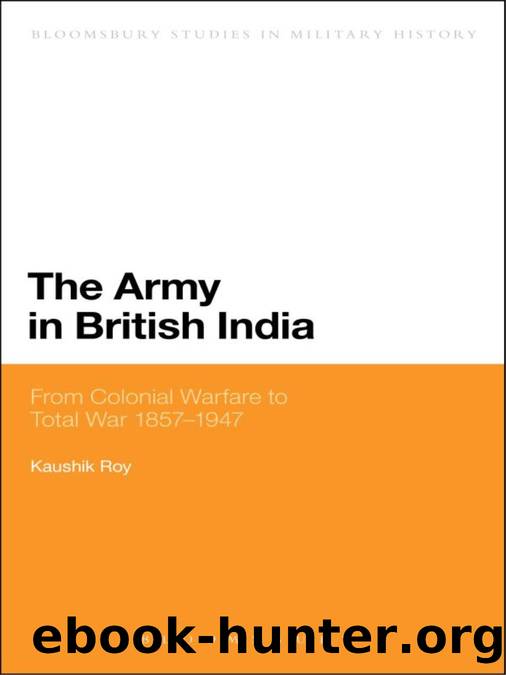The Army in British India by Roy Kaushik;

Author:Roy, Kaushik;
Language: eng
Format: epub
Publisher: Bloomsbury Publishing Plc
Published: 2019-11-23T00:00:00+00:00
Limited modernization of the Army in India in the late 1930s
In 1937, India was under the obligation of sending five infantry brigades plus two battalions for overseas duty. Of the above-mentioned infantry brigades, three were to be deployed in the western arc of the British Empire and two infantry brigades plus the two battalions were destined for the eastern arc of the British Empire.81 The eastern arc means the regions east of the subcontinent which had been under British control. And the western arc refers to the areas west of India that had been of interest to Britain.
The Chatfield Committee warned that the Afghan Army was in the process of acquiring medium and field artillery. However, assured the committee, operation in the neighbouring regions of India will never be as intense as in Europe.82 According to the recommendations of the Chatfield Committee which submitted its report just before the outbreak of the war, India was destined to play a limited role as regards overseas defence. The units earmarked for overseas defence were known as External Defence Troops (hereafter EDTs). The equipment of the EDTs was to be on a higher scale compared to the other units of India. This is because the EDTs were supposed to confront units of the first class military powers. In the EDTs, each field artillery regiment was to have 24 instead of 16 guns. The infantry battalions of the EDTs were earmarked for more light machine-guns, anti-tank rifles, mortars and carrier platoons plus armoured tracked carriers. Compared to an ordinary infantry battalion, an EDT battalion was supposed to possess 65 instead of 48 motor vehicles. Due to lack of trained artificers in India, repair facilities for the motor vehicles were inadequate. And this in turn somewhat hampered motorization and mechanization of the army.83 The Chatfield Committee noted: âAgain, so far as the various components of the forces are concerned, internal security troops and the general reserve would as far as possible be modernized first, in view of the relatively higher degree of mobility required for these units.â84 India was expected to maintain one division of EDTs. Of this division, one brigade was supposed to go to Malaysia and the rest to Egypt. The size of the Army in India was 237,500. The Chatfield Committee further recommended that the size of the Army in India should be reduced by disbanding some British and Indian units to pay for the modernization of the rest of the existing units.85
A process of limited mechanization and partial reduction of the army was already in motion even before the intervention of the Chatfield Committee. In February 1938, it was decided that the 13th Lancers and the Scinde Horse were to be converted into armoured car regiments by issuing them 15 cwt. trucks. A Modernization Committee under Claude Auchinleck was appointed in October 1938. It recommended 26 crores of rupees for motorization of some units. The expenditure was to be met by the reduction of two British and two Indian cavalry regiments and five British and five Indian infantry battalions.
Download
This site does not store any files on its server. We only index and link to content provided by other sites. Please contact the content providers to delete copyright contents if any and email us, we'll remove relevant links or contents immediately.
| Central Asia | Southeast Asia |
| China | Hong Kong |
| India | Japan |
| Korea | Pakistan |
| Philippines | Russia |
The Rape of Nanking by Iris Chang(3526)
The Sympathizer by Viet Thanh Nguyen(3510)
World without end by Ken Follett(3010)
Ants Among Elephants by Sujatha Gidla(2928)
Blood and Sand by Alex Von Tunzelmann(2611)
Japanese Design by Patricia J. Graham(2562)
City of Djinns: a year in Delhi by William Dalrymple(2139)
Inglorious Empire by Shashi Tharoor(2103)
In Order to Live: A North Korean Girl's Journey to Freedom by Yeonmi Park(2062)
Foreign Devils on the Silk Road: The Search for the Lost Treasures of Central Asia by Peter Hopkirk(2059)
Tokyo by Rob Goss(2022)
India's biggest cover-up by Dhar Anuj(1989)
India's Ancient Past by R.S. Sharma(1988)
The Great Game: On Secret Service in High Asia by Peter Hopkirk(1962)
Tokyo Geek's Guide: Manga, Anime, Gaming, Cosplay, Toys, Idols & More - The Ultimate Guide to Japan's Otaku Culture by Simone Gianni(1949)
Goodbye Madame Butterfly(1938)
The Queen of Nothing by Holly Black(1760)
Living Silence in Burma by Christina Fink(1734)
Batik by Rudolf Smend(1724)
